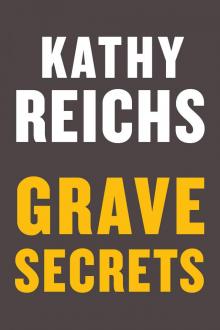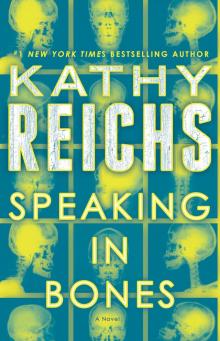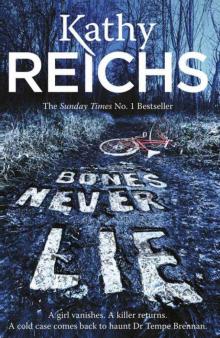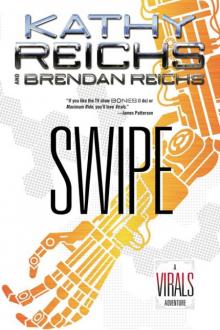- Home
- Kathy Reichs
Cross Bones Page 10
Cross Bones Read online
Page 10
“Yes, it is.” The painting had an ethereal quality that really was beautiful.
“Edward Burne-Jones. Do you know him?” Morissonneau asked.
I shook my head.
“He was a Victorian English artist, a student of Rossetti. Many Burne-Jones paintings have an almost dreamlike quality to them. This one is titled The Morning of the Resurrection. It was done in 1882.”
Morissonneau’s gaze lingered a moment on the painting, then his jaw tightened and his lips went thin. Circling the desk, he set the crate on the blotter and resumed his seat.
Morissonneau paused a moment, collecting his thoughts. When he spoke his tone was again tense.
“The monastic life is one of solitude, prayer, and study. I chose that.” Morissonneau spoke slowly, putting pauses where pauses wouldn’t normally go. “With my vows, I turned my back on involvement in the politics and concerns of this world.”
Morissonneau placed a liver-spotted hand on the crate.
“But I could not ignore world events. And I could not turn my back on friendship.”
Morissonneau stared at his hand, engaged, still, in some inner struggle. Truth or dare.
Truth.
“These bones are from the Musée de l’Homme.”
A match flared in my chest.
“The skeleton stolen by Yossi Lerner.”
“Yes.”
“How long have you had it?”
“Too long.”
“You agreed to keep it for Avram Ferris?”
Tight nod.
“Why?”
“So many ‘whys.’ Why did Avram insist that I take it? Why did I consent? Why have I persisted in this shared dishonesty?”
“Start with Ferris.”
“Avram accepted the skeleton from Yossi because of loyalty, and because Yossi convinced him that its rediscovery would trigger cataclysmic events. After transporting the bones to Canada, Avram hid them at his warehouse for several years. Eventually, he grew uncomfortable. More than uncomfortable. Obsessed.”
“Why?”
“Avram is a Jew. These are the remains of a human being.” Morissonneau caressed the box. “And . . .”
Morissonneau’s head cocked up. Light reflected from one lens.
“Who’s there?”
I heard the soft swish of fabric.
“Frère Marc?” Morissonneau’s voice was sharp.
I swiveled. A form filled the open doorway. Placing fingers to lips, the scar-faced monk raised his one good brow.
Morissonneau shook his head. “Laissez-nous.” Leave us.
The monk bowed and withdrew.
Lurching to his feet, Morissonneau strode across the office and closed the door.
“Avram grew uncomfortable,” I prompted when he’d resumed his seat.
“He believed what Yossi believed.” Hushed.
“That the skeleton is that of Jesus Christ?”
Morissonneau’s eyes flicked to the painting, then down again. He nodded.
“Did you believe that?”
“Believe it? No, I didn’t believe it, but I didn’t know. Don’t know. I couldn’t take a chance. What if Yossi and Avram were right? Jesus not dead on the cross? It would be the death knell for Christianity.”
“It would undercut the most fundamental tenets of the faith.”
“Just so. The Christian faith is based on the premise of our savior’s death and resurrection. Belief in the Passion is pivotal to a creed around which one billion souls fashion their lives. One billion souls, Dr. Brennan. The consequences of the undermining of that belief would be unthinkable.”
Morissonneau closed his eyes, imagining, I could only guess, unthinkable consequences. When he opened them, his voice was stronger.
“Avram and Yossi were probably wrong. I don’t believe these are the bones of Jesus Christ. But what if the press picked up on the story? What if the cesspool that is today’s mass media engaged in one of their nauseating spectacles, selling their souls for a larger share of the audience for the six o’clock news? The ensuing controversy alone would be a catastrophe.”
He didn’t wait for a reply.
“I’ll tell you what would happen. A billion lives would be wrenched out of joint. Faith would be subverted. Spiritual devastation would be rampant. The Christian world would be cast into crisis. But it wouldn’t end there, Dr. Brennan. Like it or not, Christianity is a powerful political and economic force. Collapse of the Christian church would lead to global upheaval. Instability. World chaos.”
Morissonneau punched the air with one finger.
“Western civilization would be torn loose at the roots. I believed that then. I believe that even more fervently now, with Islamic extremists pushing their new brand of religious fanaticism.”
He leaned forward.
“I am Catholic, but I have studied the Muslim faith. And I have watched closely developments in the Middle East. Even back then, I saw the unrest and knew a crisis was looming. Do you remember the Munich Olympic games?”
“Palestinian terrorists kidnapped part of the Israeli team. All eleven athletes were killed.”
“The kidnappers were members of a PLO faction called Black September. Three were captured. A little over a month later, a Lufthansa jet was hijacked by more terrorists demanding the release of the Munich killers. The Germans complied. That was 1972, Dr. Brennan. I watched the news coverage, knowing it was just the beginning. Those events took place one year before Yossi stole the skeleton and gave it to Avram.
“I am a tolerant man. I have nothing but the highest regard for my Islamic brethren. Muslims generally are hardworking, family-centered, peace-loving people who adhere to the same values you and I hold dear. But, among the good, there exists a sinister minority driven by hate and committed to destruction.”
“The jihadists.”
“Are you familiar with Wahhabism, Dr. Brennan?”
I wasn’t.
“Wahhabism is an austere form of Islam that blossomed on the Arabian Peninsula. For over two centuries it’s been Saudi Arabia’s dominant faith.”
“What distinguishes Wahhabism from mainstream Islam?”
“Insistence on a literal interpretation of the Koran.”
“Sounds like good old Christian fundamentalism.”
“In many ways it is. But Wahhabism goes much further, calling for the complete rejection and destruction of anything and everything not based on the original teachings of Muhammad. The sect’s explosive growth began in the seventies when Saudi charities started funding Wahhabi mosques and schools, called madrassas, everywhere from Islamabad to Culver City.”
“Is the movement really that bad?”
“Was Afghanistan that bad under the Taliban? Or Iran under the Ayatollah Khomeini?”
Morissonneau didn’t pause for an answer.
“Wahhabis aren’t simply interested in minds and souls. The sect has an ambitious political agenda focused on the replacement of secular leadership with a fundamentalist religious governing group or person in every Muslim country on the planet.”
Jingoist paranoia? I kept my doubts to myself.
“Wahhabis are infiltrating governments and the military throughout the Muslim world, positioning themselves in anticipation of ousting or assassinating secular leaders.”
“Do you really believe that?”
“Look at the destruction of modern Lebanon leading to the Syrian occupation. Look at Egypt and the murder of Anwar Sadat. Look at the attempts on the lives of Mubarak of Egypt, Hussein of Jordan, Musharraf of Pakistan. Look at the repression of secular leaders in Iran.”
Again, Morissonneau raised a hand and pointed a finger at me. It now trembled.
“Osama bin Laden is Wahhabi, as were the members of his nine-eleven teams. These fanatics are engaged in what they call the Third Great Jihad, or holy war, and anything, anything is fair game if it advances their cause.”
Morissonneau’s hand dropped to the crate. I saw where he was going.
“Including the bones of Jesus Christ,” I said.
“Even the purported bones of Jesus Christ. These madmen would use their power to manipulate the press, twisting and distorting the issue to suit their purposes. A media circus over the authentication of Jesus’ bones would maim the faith of millions, and hand these jihadists the means to erode the foundation of the Church that is my life. If I could prevent such a travesty I felt obliged to do so.
“My primary reason for taking these bones was to protect my beloved Church. Fear of Islamic extremism was secondary back then. But as the years passed, that fear grew.”
Morissonneau drew air through his nose and leaned back.
“It became the reason I kept them.”
“Where?”
“The monastery has a crypt. Christianity has no prohibition against burial among the living.”
“You felt no obligation to notify the museum?”
“Don’t misunderstand me, Dr. Brennan. I am a man of God. Ethics mean a lot to me. This was not easy. I struggled with the decision. I have struggled with it every day.”
“But you agreed to hide the skeleton.”
“I was young when this began. God forgive me. I saw it as one of the necessary deceits of our time. Then, as time passed and no one, including the museum, seemed to be interested in the bones, I thought it best to let them lie.”
Morissonneau stood.
“But now it is enough. A man is dead. A decent man. A friend. Perhaps over nothing more than a box of old bones and a lunatic theory in a crazy book.”
I stood.
“I trust you will do everything in your power to keep this affair confidential,” Morissonneau said.
“I’m not known for my warmth toward the press.”
“So I’ve heard.”
I must have looked surprised.
“I placed a call.”
So Morissonneau’s life wasn’t all that cloistered.
“I’ll contact the Israeli authorities,” I said. “It’s likely the bones will return to them, and it’s doubtful they’ll be calling a press conference, either.”
“What happens now is in God’s hands.”
I lifted the box. The contents shifted with a soft clunking sound.
“Please keep me informed,” Morissonneau said.
“I will.”
“Thank you.”
“I’ll attempt to keep your name out of this, Father. But I can’t guarantee that will be possible.”
Morissonneau started to speak. Then his mouth closed and he quit trying to explain or excuse.
12
I DIDN’T COME CLOSE TO KEEPING WITHIN TEN miles of the limit, but luck was with me. Johnny Law was pointing his radar at some other road.
Arriving at Wilfrid Derome, I parked in the lot reserved for cops. Screw it. It was Saturday and I might have God in my Mazda.
The temperature had surged upward into the low forties, and the predicted snowfall had begun as drizzle. Dirty mounds were melting into cracks and puddling pavements and curbs.
Opening the trunk, I retrieved Morissonneau’s crate and hurried inside. Except for guards, the lobby was deserted.
So was the twelfth floor.
Setting the crate on my worktable, I stripped off my jacket and called Ryan.
No answer.
Call Jake?
Bones first.
My heart was thumping as I slipped on a lab coat.
Why? Did I really believe I had the skeleton of Jesus?
Of course not.
So who was in the box?
Someone had wanted these bones out of Israel. Lerner had stolen them. Ferris had transported and hidden them. Morissonneau had lied about them, against his conscience.
Had Ferris died because of them?
Religious fervor breeds obsessive actions. Whether these actions are rational or irrational depends on your perspective. I knew that. But why all the intrigue? Why the obsession to hide them but not destroy them?
Was Morissonneau right? Would jihadists kill to obtain these bones? Or was the good father lashing out against religious and political philosophies he viewed as threatening to his own?
No clue. But I intended to pursue answers to these questions as vigorously as I knew how.
I got a hammer from the storage closet.
The wood was dry. The nails were old. Splinters flew as each popped free.
Eventually, sixteen nails rested by the crate. Laying aside my hammer, I lifted the lid.
Dust. Dry bone. Smells as old as the first fossil vertebrate.
The long bones lay on the bottom, parallel, with kneecaps and hand and foot bones jumbled among them. The rest formed a middle layer. The skull was on top, jaw detached, empty orbits staring skyward. The skeleton looked like hundreds of others I’d seen, spoils of a farmer’s field, a shallow grave, a dozer cut at a demolition site.
Transferring the skull to a cork stabilizer ring, I positioned the jaw and stared at the fleshless face.
What had it looked like in life? Whose had it been?
Nope. No speculation.
One by one, I articulated every element.
Forty minutes later, an anatomically correct skeleton lay on my table. Nothing was missing save a tiny throat bone called the hyoid and a few finger and toe phalanges.
I was sliding a case form onto a clipboard when my phone rang. It was Ryan.
I told him about my morning.
“Holy shit.”
“Maybe,” I said.
“Ferris and Lerner were believers.”
“Morissonneau wasn’t so sure.”
“What do you think?” Ryan asked.
“I’m just starting my analysis.”
“And?”
“I’m just starting my analysis.”
“My ass ain’t mine until this stakeout’s done. But I got a call this morning. I may have caught a break on the Ferris homicide.”
“No kidding,” I said.
“When I’m cut loose here I’ll follow up,” Ryan said.
“What’s the lead?”
“When I’m cut loose here I’ll follow up.”
“Touché.”
“Damn, we’re professional,” Ryan said.
“No reckless speculation for us,” I agreed.
“Not a hasty conclusion in sight.”
When we’d disconnected I dashed to the first-floor cafeteria, devoured a tuna sandwich and Diet Coke, and raced back to the lab.
I wanted to torpedo straight to the key questions. I forced myself to stick to protocol.
Gloves.
Light.
Case form.
Deep breath.
I started with gender.
Pelvis: narrow sciatic notch, narrow pelvic inlet, chunky pubic bones bridging an inverted V in front.
Skull: bulging brow ridges, blunt orbital borders, large crests, muscle attachments, and mastoid processes.
There was no wiggle room. This skeleton was all boy.
I turned to age.
Angling my light, I observed the left pelvic half where it would have joined hands with the right pelvic half in life. The surface was pitted and slightly depressed relative to the height of an oval rim circling its perimeter. Spiny growths protruded from the rim’s upper and lower edges.
The right pubic symphysis looked the same.
I got up and walked to the watercooler.
I took a drink.
I took a breath.
Calmer, I returned to the skeleton and selected ribs three through five from both sides of the chest. Only two retained undamaged sternal ends. Laying the other ribs aside, I observed this pair closely.
Both ribs ended in deep, U-shaped indentations surrounded by thin walls terminating in sharp-edged rims. Bony spicules projected from the superior and inferior borders of each rim.
I leaned back and laid down my pencil.
Feeling what? Relief? Disappointment? I wasn’t sure.
The pubic symphyses scored a
s phase six on the Suchey-Brooks age-determination system, a set of standards derived from the analysis of the pelves of hundreds of adults of documented age at death. For males, phase six suggests a mean age of sixty-one.
The ribs scored as phase six on the Iscan-Loth age-determination system, a set of standards based on the quantification of morphological changes in ribs collected from adults at autopsy. For males, this suggests an age range of forty-three to fifty-five.
Granted, Y-chromosomers are tremendously variable. Granted, I’d yet to observe the long bones and the molar roots radiologically. Nevertheless, I was certain my preliminary conclusion would hold. I jotted it on the case form.
Age at death: forty to sixty years.
There was no way this guy died in his thirties.
Like Jesus of Nazareth.
If Jesus of Nazareth died in his thirties. Joyce’s theory had him living until eighty.
This guy fit neither profile.
There was also no way this man had lived into his seventies.
So he also failed to fit the profile of the old male from Cave 2001. But had the isolated skeleton described by Jake’s volunteer-informant actually been the old male? Maybe not. Maybe Yadin’s septuagenarian was jumbled with the commingled bones, and the isolated skeleton was another individual altogether. An individual of forty to sixty.
Like this guy.
I flipped to the next page.
Ancestry.
Right.
Most systems for racial assessment rely on variations in skull shape, facial architecture, dental form, and cranial metrics. Though I often rely on the latter, there was a problem.
If I took measurements and ran them through Fordisc 2.0, the program would compare my unknown to whites, blacks, American Indians, Hispanics, Japanese, Chinese, and Vietnamese.
Big help if crate-man lived in Israel two thousand years back.
I went through the trait list on my form. Prominent nasal bones. Narrow nasal opening. Flat facial profile when viewed from the side. Cheekbones hugging the face. On and on.
Everything suggested Caucasoid, or at least European-like ancestry. Not Negroid. Not Mongoloid.
I took measurements and ran them. Every comparison placed the skull squarely with the whites.
Okay. Computer and eyeballs were in agreement.
What then? Was the man Middle Eastern? Southern European? Jewish? Gentile? I knew of no way to sort that out. Nor did DNA testing offer any help.

 Two Nights
Two Nights The Bone Collection: Four Novellas
The Bone Collection: Four Novellas Fatal Voyage
Fatal Voyage 206 Bones
206 Bones Bones to Ashes
Bones to Ashes Terminal
Terminal Monday Mourning
Monday Mourning Flash and Bones
Flash and Bones Cross Bones
Cross Bones Devil Bones
Devil Bones Break No Bones
Break No Bones Swamp Bones
Swamp Bones Déjà Dead
Déjà Dead Shock
Shock Spider Bones
Spider Bones Death Du Jour
Death Du Jour Grave Secrets
Grave Secrets Trace Evidence: A Virals Short Story Collection
Trace Evidence: A Virals Short Story Collection Bones on Ice
Bones on Ice The Bone Code
The Bone Code Bones in Her Pocket
Bones in Her Pocket Seizure:
Seizure: Speaking in Bones
Speaking in Bones Deadly Decisions
Deadly Decisions Spike
Spike Bones Never Lie
Bones Never Lie Bones of the Lost
Bones of the Lost Virals 03.5 - Swipe
Virals 03.5 - Swipe Exposure
Exposure A Conspiracy of Bones
A Conspiracy of Bones Shift (tory brennan)
Shift (tory brennan) Bones of the Lost: A Temperance Brennan Novel tb-16
Bones of the Lost: A Temperance Brennan Novel tb-16 Virals tb-1
Virals tb-1 Bones Are Forever tb-15
Bones Are Forever tb-15 Code tb-3
Code tb-3 Seizure tb-2
Seizure tb-2 Deadly Descisions
Deadly Descisions Spider Bones: A Novel
Spider Bones: A Novel